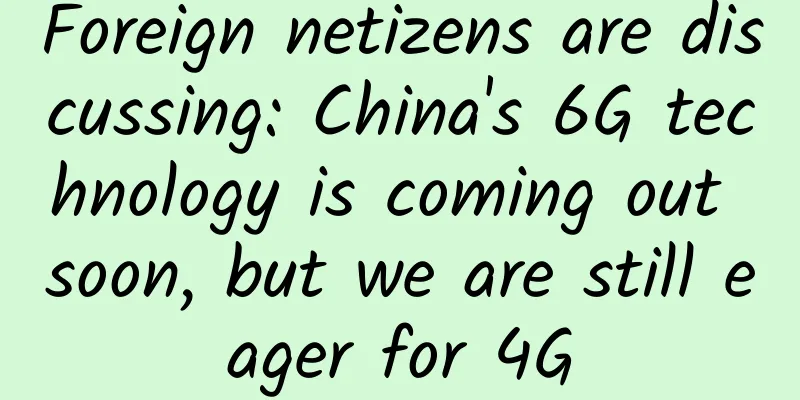In-depth analysis of China's 5G commercialization from eight dimensions: trends, challenges, development and future

|
1. Why choose June 6 to issue 5G commercial licenses? I believe that China’s decision to formally issue four 5G licenses on June 6 was the result of “comprehensive and rational” considerations. The issuance of 5G licenses before the end of the first half of the year, and the issuance of four licenses at once, exceeded most people's expectations. Around December last year, the Ministry of Industry and Information Technology also announced the issuance of trial commercial licenses, and in March this year, it released a signal that it would issue licenses at an appropriate time. However, not many people would seriously foresee that four licenses would be issued in the first half of this year, because the entire industry chain was waiting for the completion of the pilot projects in the 17 pilot cities. In the view of many senior industry insiders, the appropriate time to issue licenses before that would be early next year due to the high costs of the industry chain, especially the terminals.
However, this may be a misjudgment under rationality - a misjudgment of pure economic animal thinking. So I describe the 5G license at this time as a comprehensive rational decision: comprehensive rationality is a choice made after weighing the global 5G development pattern, competitive situation, and current situation. This choice will lead to biased conclusions in any single analysis from the perspective of technology maturity or economic cost. The development of China's 5G industry has an urgent situation that cannot wait. If we look beyond the Chinese market, we will find that some things have happened in the 5G field that are putting pressure on us. From the blockade of Chinese equipment manufacturers by Germany, Britain, Australia and Japan, to the Prague 5G security conference attended by many Western countries, to the US embargo on Huawei, a distorted force is rapidly forming. This force is a countercurrent to the market economy and globalization in the name of security, but it is coming with great force. For China's 5G industry chain, a breakthrough is needed to hedge against this distortion and countercurrent. With the scale test basically completed, issuing 5G licenses in advance is a very important and crucial choice. Through the issuance of licenses, the regulatory authorities have eliminated industry uncertainties in advance and have clearly intended to promote the development of China's 5G industry chain. The core is to create a good institutional environment for amplifying and releasing the decisive role of China's market power. This can also be clearly seen from the official statement of the Ministry of Industry and Information Technology on 5G licensing. In this consideration, it is very obvious that the development of the industry is the focus of management. Only by completing the reform on the supply side of the industry can the experience problem on the demand side (users) be truly solved. This is also a kind of comprehensive rationality. In a dilemma, you always have to choose one side. Then, in line with the principle of maximizing long-term benefits, it is in the public interest to first promote the development of the 5G supply side. Under such circumstances, the entire Chinese 5G industry chain needs to think about "how to take the overall situation into consideration". The so-called overall situation refers to the interests and development of the entire industry, not the gains and losses of one company, nor is it a low-level competition of who is faster than who, nor should it be an empty promise between upstream and downstream partners. How to form a market synergy and let the power of the Chinese market truly form a positive driving force for the global 5G industry chain is a philosophical question that the entire Chinese 5G industry chain needs to think about. Otherwise, what is the meaning of issuing 5G licenses in advance? After China issues 5G licenses, a certain confirmation mechanism will be formed for the global market for 5G technology, and the reliability of the global supply chain will be a test and selection. 2. The success or failure of 5G is a matter for the whole society, not just for telecom operators 5G is a universal technology, just like electricity. In a sense, 5G commercial use can be divided into large-scale commercial use and small-scale commercial use. Small-scale commercial use means that telecom operators are licensed to officially start network construction and operation in the traditional sense; large-scale commercial use means the deep integration of various industries with 5G. From this perspective, the success or failure of 5G is no longer a matter for telecom operators alone, but a matter for the entire society. For each industry, there should be a roadmap for 5G commercialization. At the current stage, industries that have fully realized the future prospects of 5G+ include autonomous driving, video, industrial manufacturing, and the Internet. The sign of its significance is that relevant international and domestic technical organizations, industry alliances, and national industry development guidelines have already included 5G as the most important technical element in the technology evolution plan and have begun to actively promote industrial pilots. After 5G is commercially available, telecom operators, 5G equipment manufacturers, industry organizations, national standardization organizations, and industry technology alliances should work together to first solve the problem of 5G and industry integration from the technical and standard levels. All parties should review and examine the existing industry technical standards and start discussions. Perhaps it is necessary to establish some new organizations. For example, the construction industry, smart cities, power industry, transportation industry, and manufacturing industry. The whole society needs to realize that if we do not first carry out rigorous, serious, and systematic discussions and research from the technical specifications and standards level, and update the industry's standard system, the integration of 5G and the industry will be an impossible dream. The CEO of each industry's leading manufacturer (yes, not the CIO) needs to consider the challenges to their market position and business after the arrival of 5G. If we observe the progress of each generation of information technology, we will find that the cyclical replacement of key technologies that affect society has the greatest impact on industry giants. Taking the communications industry itself as an example, giants that have disappeared include Nortel Networks and Motorola. There are even more cases of giants in traditional industries being eliminated under the impact of new technologies. Of course, the most important thing is to prepare talents and budgets for 5G. Whether you are a CIO or a CEO, you need to immediately prepare the corresponding talents for 5G, put the recruitment and training of 5G talents on the agenda; and prepare the corresponding budget for each business department. Obviously, the government is one of the key forces driving the development of 5G. If we agree that 5G is a general technology like electricity, we can recall the coal-to-electricity conversion that was vigorously promoted this year. The government provided policy guidance and fiscal subsidies to accelerate the process of coal-to-electricity conversion. Then we may call for the adoption of 5G. It is necessary to introduce relevant fiscal and taxation support policies. This is a technical guidance. You can regard 5G as a technical transformation. Providing financial subsidies will be appropriate and necessary. The goal is for the government to provide a tendency guidance for the economic development of the entire society through fiscal and taxation policies. 3. Using one license to solve the 700 MHz frequency band problem is Chinese wisdom. China Radio and Television welcomes participation The issue of the 700M frequency band remains unresolved, but the issue of 5G licensing has undergone fundamental changes. It is China's wisdom to provide China Radio and Television with a 5G license. As early as 2018, I wrote an article calling for 700M to be given to radio and television, which is a great thing. There are three reasons: First, in terms of competition model, since it is derived from the administrative system, I believe that State Grid’s 5G approach will be completely different from the purely market-oriented approach of the three major telecom operators, which will be conducive to innovation and learning of the three major operators; second, it will expand the scale of China’s 5G market, which is beneficial to Chinese telecom equipment manufacturers; third, it is beneficial to users, who can experience more of the rich and colorful new service experiences brought by marketization and non-marketization. Providing a 5G license to China Radio and Television has at least three meanings: First, it can expand the scale of China's 5G market and accelerate the development of the 5G industry. The 700M frequency band may become the main frequency band for China Radio and Television to carry out 5G operations. The high-quality low-frequency dividends are incorporated into mobile communications, and the problems that have not been solved for many years have been fundamentally solved. This will further promote the internal resource integration of the radio and television system and introduce new capital players to China's 5G development. Second, China's 5G frequency band allocation is synchronized with the world, which is conducive to enjoying the global frequency band dividend. The well-known self-media Netyou Mercenary Army once did a statistics on the 700M frequency band 5G allocation in major countries around the world. The United States (70M), Japan (120M), France (110M), Germany (60M), Singapore (90M), Russia (60M), South Korea (40M), and the United Kingdom (60M) have already used this frequency band for 5G and auctioned it to telecom operators. The issuance of 5G licenses to China Radio and Television this time can be said that in terms of mainstream frequency bands, China's frequency band allocation pattern will be consistent with that of the global telecommunications industry. The addition of the 700M spectrum will have a huge accelerating effect on the development of China's 5G industry. A new industrial chain will emerge, and the average cost of network coverage will also be reduced in the long term. Third, China Radio and Television's operation of 5G will enrich the scenarios of 5G. We need to recognize the fact that China Radio and Television has a natural genetic advantage in integrating the video content industry in terms of system. The 5G license provides China Radio and Television with a bargaining chip for integrated operations, and the negotiating position and difficulty of integration of cable networks and TV stations in various regions will be reduced. This will provide a valuable scenario for the development of 5G within two years. Of course, some people may argue that China's radio and television itself has a complex structure and great integration challenges, and lacks sufficient capital to build a large-scale 5G network, and even lacks professional operation personnel. In my opinion, this is a static view. In fact, these problems are not unsolvable. As long as the industry is given opportunities for development, problems can be solved dynamically in the process of development. The key lies in the top-level institutional design. We must clear the obstacles for the 700M frequency band to join the 5G circle of friends, and leave the rest to the market. 4. Funding is a key issue in 5G construction, but there are solutions 5G will require a lot of capital. This is a well-known problem. More dense base stations, more energy requirements, and new maintenance and operation technologies all require a lot of capital investment. Therefore, the success or failure of 5G development will be subject to the scale of capital and the time stage of investment. In the past few years, China's broadband strategy has been implemented, and the speed-up effect has been very significant. As a national strategy, its main implementer is telecom operators. Through large-scale capital investment, China's base station scale, optical fiber mileage, and network capacity have quickly become the world's first, and universal service has been achieved. In the 5G era, it is necessary to continue to implement the national broadband strategy, but I think the implementation subject should be expanded. Although it is not necessary for the whole nation to raise funds in disguise to develop the communications industry in the early stages of the development of the communications industry, at least in terms of financing models, it should be for telecom operators and equipment manufacturers. Terminal manufacturers provide top-level design at the policy level, especially telecom operators as the downstream of the industrial chain, which need to provide some new financing mechanism in the construction of the network in order to achieve the source of living water. Of course, the entire society also needs to re-examine the strategy of speeding up and reducing fees that has been implemented for many years from a big picture perspective, and strike a balance between short-term needs and long-term sustainable development. Capital is a problem, but as a general technology that can change society, if there is a suitable top-level design, profit-seeking capital will not miss this huge opportunity. The key is how we can build a world-leading 5G infrastructure network in a short period of time and regard this infrastructure as a public good and provide policy support. 5. Don’t worry, NSA is just a short-term solution. Everyone knows SA is the future. At present, the commercially deployed 5G version is NSA, which is a non-standalone network and mainly supports eMBB services, namely enhanced mobile broadband. This is somewhat different from the long-term commitment of the 5G standard, namely support for industry scenarios. First, the standards supporting SA have not yet been completely frozen; second, based on realistic cost considerations, 5G can be quickly deployed with the help of existing 4G networks. Some people think this is a compromise. In my opinion, this is a kind of technological idealism. The development of any new technology needs to be recognized and fully recognized by "people". From the perspective of individual psychological structure and cognitive structure, 5G first provides an experience that individuals can directly perceive, which will first provide confidence to the market and complete the popularization and education of 5G. After deploying NSA, SA can be said to have a natural effect: NSA completes the market popularization education, allowing 5G to cross the technological gap and enter the rapid popularization stage; SA follows the trend and shortens the adoption cycle in industry scenarios. On the contrary, if we wait for SA from the beginning, then when individuals have not yet fully understood and experienced 5G, it will inevitably increase the complexity of the situation and may cause the entire society to lose confidence in 5G. More importantly, NSA can provide financial support for the deployment of SA and alleviate the difficulties of large-scale investment by telecom operators and customers in industry scenarios. In addition, as mentioned earlier, the widespread application of SA also requires industry standardization organizations to revise technical standards, which takes time and patience. During this period, advancing through demonstration and verification will not affect long-term development. Among telecom operators, China Mobile and China Telecom have made it clear that SA is their goal. For example, since 2019, China Telecom has launched an expanded pilot of SA+NSA hybrid networking in 8 cities including Beijing, and has realized a 5G scale test network with cross-domain connectivity in multiple provinces and regions. So there is no need to worry that China's 5G will not be ahead in this regard. Huawei announced in December 2018 that it had passed the 5G independent networking (SA) test organized by the Ministry of Industry and Information Technology. The maturity of the technology is not a problem. 6. The biggest challenges facing telecom operators are challenges in thinking and organization The issuance of 5G licenses is a huge opportunity for telecom operators, but also the beginning of a huge challenge. It can be said that telecom operators are not really ready for 5G from thinking to organization. The pipeline thinking is deeply rooted, and the arrival of 5G is a huge challenge for telecom operators. Consulting firm STL Partners defines the telecommunications industry as the "collaboration era," which has two basic characteristics:
STL Partners bluntly pointed out that the goal pursued by telecom operators, "improving the world's connectivity and getting more people online, is unlikely to generate a lot of new revenue for telecom companies" because it is no longer a "big problem" that the entire society needs to solve. Politicians, social activists, economists and entrepreneurs do not pay attention to this issue at all because it is not a problem they are eager to solve. However, telecom operators around the world, especially those in China, are still thinking about how to charge for traffic and how to increase users in the 5G era. In the eyes of the entire society, these are just "trivial matters". The capital market, the public and politicians do not pay any attention to them at all. If telecom operators do not shift their focus away from their own growth in the 5G era and pay attention to and study the problems of society as a whole, it will only be a matter of time before they are left behind by the times. Organizational challenges are another severe challenge facing telecom operators. Starting from the fixed-line era, the organization was mainly based on territorial operations according to administrative divisions. Although in the mobile Internet era and the 4G era, telecom operators have made adjustments to the model of specialized vertical field operations, the organizational operation model based on territorial operations has not changed in essence. The business characteristics of 5G are beyond regions, across industries, beyond operators, and beyond organizations; this is incompatible with territorial operations based on administrative divisions; and more importantly, the quasi-administrative management organizational control model and the top-down KPI baton mechanism will appear more rigid in the face of complex industry markets, the gradual integration of large-scale industries, and the integration of the upstream and downstream industrial chains of enterprises themselves. 5G requires telecom operators to completely change their organizational structure and organizational operation model. This topic has just begun. I think it is a huge challenge and the key to success or failure in the 5G era. Previously, the author mentioned a point of view that the core task of telecom operators in the 5G era is to find and build a talent team composed of economists, sociologists, and industry scientists, and to build a knowledge production capacity system that can understand the problems of human beings, countries, society, and people. Then, organizational changes also need to be adjusted according to the tasks. 7. What are the challenges that China must overcome in developing 5G? The issuance of 5G licenses is the starting gun for China's 5G development, but it is just the beginning. There are still many challenges to overcome for real development. In the short term, China's 5G development requires large-scale network construction. China Mobile has announced that it will accelerate the deployment of 5G networks and is expected to provide 5G services in more than 40 cities by the end of September this year, allowing users to activate 5G services without changing cards or numbers. However, network construction cannot be achieved overnight. It requires equipment vendors such as Huawei, Nokia Bell, and Ericsson to provide sufficient equipment, and Qualcomm, Intel, etc. to provide chip production capacity. It also takes a period of time for telecom operators to deploy networks. How many cities can be opened depends on the coordination of the 5G industry chain. 5G terminals are another threshold. Currently, the mobile phones that can support 5G are mainly Huawei, OPPO, OnePlus, Xiaomi, and Samsung. Due to the feud between Apple, the largest player, and Qualcomm and Intel, it seems that there is no hope for Apple to launch 5G mobile phones in 2019. Whether it is style or price, 5G mobile phones still need time. It will take at least one year for the entire terminal industry chain to prepare popular 5G terminals. This is an objective industry law. 5G native applications are still on the way. In this regard, the 4K/8K live broadcast, drones, VR/VR/XR, cloud games, autonomous driving, smart factories, and remote surgery that can be experienced at present are mostly still highbrow. 5G native applications still require joint innovation between traditional industries and the telecommunications industry. The key is the cost of investment in innovation. Considering that innovation is a matter for a few people and a high-risk matter, we cannot expect to have killer 5G applications in the short term, or we can only look for 5G enhanced applications from 4G killer applications. Security is another key challenge for 5G development. With the introduction of a new IP-based network architecture and new business models, the entire 5G security mechanism has undergone fundamental changes. 5G has emerged as the cornerstone of the digital society. Together with AI and IoT, it will form the infrastructure of the future digital society. Completely different from 4G, 3G, and 2G, 5G can support large-scale device connections (automobiles, medical equipment, industrial control equipment), introduce new businesses in vertical industries (autonomous driving, remote surgery, industrial Internet), and a new cloud and IP-based architecture (SDN/NFV), which brings new challenges to the security architecture of 5G. In 2018, Wipro released a cybersecurity report, which listed the key challenges related to 5G security. First, in terms of vertical industry scenarios, it listed the potential security risks and new security requirements that may be brought about by the introduction of 5G in typical scenarios, such as attacks on automotive networks in autonomous driving scenarios, and secure management of personal data, factors and real-time channels in remote surgery and medical scenarios; second, the potential security threats brought about by the openness and orchestration of the network brought about by the introduction of new cloud and virtualization technologies (SDN, NFV); third, the cross-domain and cross-layer security risks brought about by the introduction of slicing technology into the 5G architecture. Therefore, in the 5G era, everything valuable and able to benefit from connectivity will be connected to the network, which means that the key starting point for thinking about 5G security is: how to protect these valuable assets and the benefits generated in real time. And the dimension of thinking will not be limited to technical attacks, but also to prevent social engineering attacks and prevent butterfly effect-style security collapse. 8. What policies are needed to promote the development of 5G? As mentioned earlier, 5G is a matter for the whole society. It concerns the construction of the cornerstone of the entire digital society, the competition for discourse power in the global industrial chain, and even the future network security. Therefore, it is obvious that the development of 5G requires some positive supply at the industrial policy level. In my opinion, the development of 5G should be elevated to the strategic level of the cornerstone of the entire economic and social development, and industrial policy design should be carried out. In the telecommunications industry itself, moderate fiscal and tax policy support will be necessary, especially for the innovative research and development of new technologies, new applications and new terminals based on 5G. There are two areas that I think need special attention: one is the new industry platform, and the other is the new terminals integrated with 5G. Capital operation will be an important element in the 5G era. Just in the telecommunications industry, the current investment management and control mechanisms and models may need to make some key adjustments. It would be better to provide sufficient venture capital support for 5G innovation in terms of risk control and investment incentives. The technological transformation and innovation funds of some industries should include the adoption of 5G in the scope of assessment and support, such as banks' technological transformation loan projects, special fiscal incentive funds for the real economy, etc., and give priority support to 5G in real time. Of course, if we can provide some kind of incentives and support to the R&D and scientific research talents in the 5G industry chain, that would be the fundamental cause of 5G development. In addition, I believe that China should provide policy incentives specifically for innovation in business models based on 5G. Business models are a kind of intellectual property and creativity. The protection of business models is also the protection of intellectual property rights. One of the keys to the success or failure of 5G is the innovation of business models. Since June 6, China has entered the 5G era. The license has been issued, but it is just the beginning. The real popularization of 5G requires more sustainable efforts in top-level design, industrial collaboration, model innovation, policy support, operational innovation, and talent training. This requires time, patience, collaboration, innovation, and wisdom. |
<<: 5G is coming! How much does a 5G phone cost? Do you know the 5G charging standards?
>>: 5G is here! How long will it take for it to be truly universally adopted?
Recommend
Sharktech: Los Angeles high-defense server 1Gbps unlimited traffic starting at $129/month, optional 10Gbps unlimited traffic
Sharktech is a long-established foreign hosting c...
The Internet’s “high-salary list” has been revealed, will the Internet of Things take over?
"Reuters reported that Huawei plans to incre...
RAKsmart: 5+253 IP cluster servers starting at $177 per month, with data centers in Los Angeles/San Jose/Japan/Hong Kong available
Earlier this month, we shared the popular cloud s...
China Unicom and China Telecom refuted the rumor that some 5G networks were shut down and the first batch of users were abandoned
Some media reported that "the first tens of ...
5G may disappoint consumers because it has no other advantages except fast speed
Less than four years after the issuance of 4G lic...
Huawei focuses on intelligent scenarios in five major industries and releases new products in the F5G-A series
During Huawei Connect 2024, the All-Optical Summi...
Analysis of the reasons for IP address blocking and the help of IP proxy for IP restriction
In addition to the support of basic network cable...
A network like a boyfriend: A study of intent-based networking systems from Gartner
Intent-based networking is just getting started, ...
Comprehensive promotion of 5G construction requires full participation from all parties
Although the top leadership has once again clarif...
Building a full-scenario smart ecosystem, Huawei HMS Global Application Innovation Competition is launched
[June 10, Beijing] The 2021 Huawei HMS Global App...
Is the neighbor Wang using the internet for free? This is how you should punish him on the spot
Have you ever found yourself always experiencing ...
It is estimated that by the end of 2020, the number of 5G users in North America will reach 20.9 million
North America is currently one of the most develo...
A curve shows what stage 5G, autonomous driving, and AI have reached
Recently, Gartner, a world-renowned IT market res...
Virtual Private Server Operation Beginner's Guide
A Virtual Private Server (VPS) is a popular hosti...









